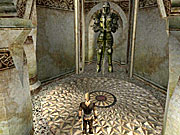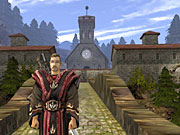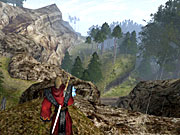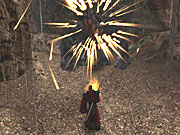Gothic II Preview
The US version of Piranha Bytes' free-form first-person role-playing game is receiving an extra layer of polish, courtesy of Atari.
It's not often that a game released in Europe is later picked up by a major publisher, and then released in the US. But Atari is in the process of doing just that with Gothic II. JoWood released the game in Europe last year, and it has done quite well, selling more than 200,000 copies in Germany alone. Developer Piranha Bytes had already localized the game, but the version that reaches US shores will be somewhat different, and it should benefit from the additions that Atari is making. The publisher expects that it will be worth the wait for this role-playing sequel, which builds on the action-oriented melee combat, free-roaming adventure, and epic story that defined Gothic.

Gothic II will expand on the previous game in a number of ways. For instance, your initial choice of one of the game's three characters has far-ranging consequences throughout the game, not only affecting the obvious things like your abilities, but also affecting how the story unfolds. The three careers--militiaman, magician, and mercenary--basically fit the old fighter, wizard, and thief archetypes, but character development won't strictly be linear. Each character will start out in a different location in the world, encounter different people, and be presented with different missions. As a militiaman, you start out in the city of Khorinis and eventually become a multitalented and righteous paladin. By contrast, the magician starts out in the monastery that houses the local order of mages and works toward becoming a fire wizard, and the lawless mercenary calls a rugged encampment home and has a career path that leads to becoming a dragon hunter.
No matter which profession you choose, the overarching story and main quests will be the same, even if you see them from a unique perspective. As the opening of Gothic II reminds you, the first game ended with the defeat of the Sleeper, but surprisingly, his minions continue to threaten the land. In a bid to deal with the evil's source, your wizard mentor Xardos sends you on a quest for an ancient relic, which in turn will help you fight a group of dragons and later discover the mysterious power behind them. Fortunately, you won't have to worry about reading long passages of text to get the gist of the story, since the designers have gone through the trouble of recording every line of speech in the game.

The first chapter in the game takes place in the temperate land near the city of Khorinis. All three of the game's maps are massive, seamless environments, and we watched as the camera flew through the variety of forests, canyons, dungeons, and urban areas that make up the adventure's first and most picturesque location. As in the original game, Gothic II makes the world feel more immersive with a day-night cycle that the world's inhabitants follow as they go about their daily business. These other characters aren't just standing around waiting for you to save them, either, and those in outlying areas will take it upon themselves to guard their lands by attacking any creatures that encroach. But if you do help them, you can improve your reputation with them, which may later open up new dialogue or quest options. Naturally, you'll also have plenty of motivation to slay creatures just to improve your own abilities.
Quests, Skills, And Trades

As you'd expect, developing a mage character in Gothic II will give you access you many bigger and better spells. There are 30 spells in all, including several levels of elemental offensive spells, summoning spells, and special offensive enchantments, like one that shrinks creatures to a fraction of their normal size (and reduces their health accordingly). But the game will also offer qualitative rewards for the other character types. As characters gain experience levels, they're awarded points that can be used to improve basic skills, such as weapon accuracy. More-fundamental skill improvements require special training in a specific discipline and give you more melee attacks, better defensive abilities, and sharper-looking combat animations that reflect a certain level of expertise with your weapon. These sorts of skills are determined by a three-level ranking system, from rookie to master, for the basic weapon types, and it's necessary to search out a master teacher to make the jump from one rank to the next.
This weapon mastery system seems to have the most effect on the melee combat, which is also the most action-oriented part of the game. Melee combat involves combinations that require clicking the attack button at precise moments during a weapon's swing and timing blocking moves. This close-quarters combat system is designed to demand some coordination and skill, but the ranged and magic attacks are based solely on character stats. Everything happens in real time, and multiple monsters can crowd around you, so regardless of how you approach them, the game's battles will be fast-paced. Magicians can assign spells and potions to hotkeys to make sure a number of options are just a keystroke away.
Another important element of character development is the trade system. There will be four major trades in the game: hunting, smithing, rune crafting, and alchemy. Each of these represents a way to craft items to use and sell. For example, a hunter can collect pelts and other trophies from downed creatures and can also craft bows. Specific trades can work well with your character's career choice. For instance, the blacksmith trade teaches you how to make weapons for yourself, which is useful if you choose to be a militiaman. Similarly, rune crafting requires you to combine ingredients to create new spells, and alchemy requires you to learn potion recipes--both useful skills for a mage. Like with weapon masteries, learning a primary trade and dabbling in other ones will require you to find a teacher and complete some of the many subquests throughout the game.

There's plenty to do in Gothic II, and Atari producer David Brown noted that completing the main quest and some important subquests should take more than 50 hours. The free-form design means that players should find lots to do no matter what direction they adventure in, and some may try out all three of the characters to uncover their differing motivations for undertaking Xardos' quest. It's not even possible to visit some areas unless you play as a specific character--a goody-goody militaman, for example, would be turned away from the rough frontier camp that becomes the mercenary's base. And while the forested areas near the city of Khorinis may be the most visually pleasing part of the game, you'll find much more challenging threats when you move to the valley of the mines, a grey and bleak location from the first game that has been completely redrawn. We'll delve deeper into Gothic II's adventures before the game is released in October.
Editor's note 07/21/03: The preview originally had inaccurate information about the original release date and localization. GameSpot regrets the error.
Got a news tip or want to contact us directly? Email news@gamespot.com
Join the conversation